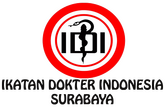Non-Obstructive Azoospermia with Hypergonadotropic Hypogonadism without a Significant Abnormalities in the Physical Examination
Downloads
Background: Around 10 % of infertile men and 1 percent of all males have azoospermia. There are two types of azoospermia, which are obstructive and non-obstructive azoospermia. Non-obstructive azoospermia's main mechanism is because the testes fail to produce the sex hormone and induce spermatogenesis (primary testicular failure).
Case: A patient is 28 years old and has a job as a car paint worker. He came with the chief complaint of infertility since two and a half years ago. He and his wife were having intercourse 3-4 times a week. Past medical history is unremarkable. His wife's medical history is also unremarkable. Physical examination and ultrasound of the testes are normal. The semen analysis in this patient was azoospermia for 2 different times in the span of 2 weeks with no abnormalities in the accessory gland. Hormonal profiles results are testosterone level 2,32 ng/mL and FSH 15,03 mIU/mL, which indicatehypergonadotropic hypogonadism. The patient was suggested to evaluate further (complete hormonal profile, karyotyping analysis, and Y-Chromosome microdeletion) and educate about the possibility to conceive with assisted reproductive technology (ART).
Discussion: Hypergonadotropic hypogonadism is a challenging case that needs a complete assessment such as complete hormonal profile, karyotyping analysis, Y-chromosome microdeletion analysis, and also, in this case, the paint thinner exposure in the workplace is needed to be considered. The chance of normal conception is very small, and the assisted reproductive procedure is necessary.
Conclusion: Some abnormalities are usually present in the physical examination of azoospermia patients. This case convinces us of the importance of thorough history taking and other investigations. Managing this patient will be challenging, with the goal of the therapy is to achieve spermatogenesis to be able to use the spermatozoa available for ICSI.
WHO. International Classification of Diseases, 11th Revision (ICD-11).
Agarwal A, Mulgund A, Hamada A, et al. A Unique View on Male Infertility Around The Globe. Reprod Biol Endocrinol 2015; 13: 1–9.
Cocuzza M, Alvarenga C, Pagani R. The Epidemiology and Etiology of Azoospermia. Clinics (Sao Paulo) 2013; 68 Suppl 1: 15–26.
Kumar R. Medical Management of Non-Obstructive Azoospermia. Clinics (Sao Paulo) 2013; 68 Suppl 1: 75–79.
Dabaja AA, Schlegel PN. Microdissection Testicular Sperm Extraction: An Update. Asian J Androl 2013; 15: 35–39.
WHO WHO. WHO Laboratory manual for the examination and processing of human semen - 6th. 2021.
Xiao G, Pan C, Cai Y, et al. Effect of Benzene, Toluene, Xylene on The Semen Quality And The Function Of Accessory Gonad of Exposed Workers. Ind Health 2001; 39: 206–210.
Jarvi K, Lo K, Grober E, et al. CUA Guideline: The Workup and Management of Azoospermic Males. Can Urol Assoc J 2015; 9: 229–235.
Shiraishi K. Hormonal Therapy for Non-Obstructive Azoospermia: Basic and Clinical Perspectives. Reprod Med Biol 2015; 14: 65–72.
Selman HA, Cipollone G, Stuppia L, et al. Gonadotropin Treatment of An Azoospermic Patient with A Y-Chromosome Microdeletion. Fertil Steril 2004; 82: 218–219.
Chiba K, Enatsu N, Fujisawa M. Management of Non-Obstructive Azoospermia. Reprod Med Biol 2016; 15: 165–173.
Ramasamy R, Yagan N, Schlegel PN. Structural and Functional Changes to The Testis After Conventional Versus Microdissection Testicular Sperm Extraction. Urology 2005; 65: 1190–1194.
Vahidi S, Horoki AZ, Talkhooncheh MH, et al. Success Rate and ART Outcome of Microsurgical Sperm Extraction in Non Obstructive Azoospermia: A Retrospective Study. Int J Reprod Biomed 2021; 19: 781–788.
Copyright (c) 2022 Indonesian Andrology and Biomedical Journal

This work is licensed under a Creative Commons Attribution-ShareAlike 4.0 International License.

















